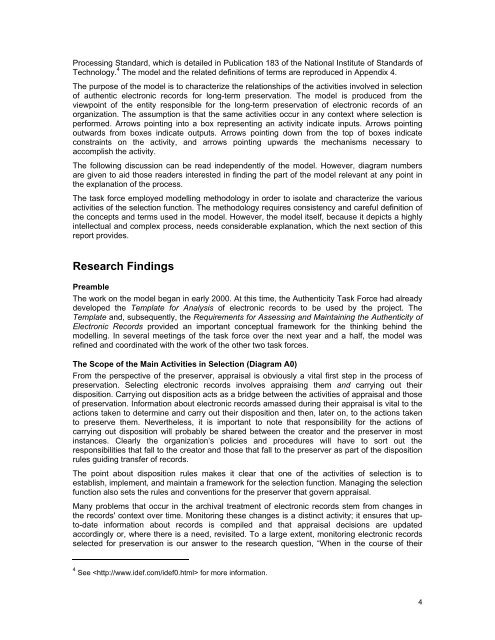Appraisal Task Force Report - The InterPARES Project
Appraisal Task Force Report - The InterPARES Project
Appraisal Task Force Report - The InterPARES Project
You also want an ePaper? Increase the reach of your titles
YUMPU automatically turns print PDFs into web optimized ePapers that Google loves.
Processing Standard, which is detailed in Publication 183 of the National Institute of Standards of<br />
Technology. 4 <strong>The</strong> model and the related definitions of terms are reproduced in Appendix 4.<br />
<strong>The</strong> purpose of the model is to characterize the relationships of the activities involved in selection<br />
of authentic electronic records for long-term preservation. <strong>The</strong> model is produced from the<br />
viewpoint of the entity responsible for the long-term preservation of electronic records of an<br />
organization. <strong>The</strong> assumption is that the same activities occur in any context where selection is<br />
performed. Arrows pointing into a box representing an activity indicate inputs. Arrows pointing<br />
outwards from boxes indicate outputs. Arrows pointing down from the top of boxes indicate<br />
constraints on the activity, and arrows pointing upwards the mechanisms necessary to<br />
accomplish the activity.<br />
<strong>The</strong> following discussion can be read independently of the model. However, diagram numbers<br />
are given to aid those readers interested in finding the part of the model relevant at any point in<br />
the explanation of the process.<br />
<strong>The</strong> task force employed modelling methodology in order to isolate and characterize the various<br />
activities of the selection function. <strong>The</strong> methodology requires consistency and careful definition of<br />
the concepts and terms used in the model. However, the model itself, because it depicts a highly<br />
intellectual and complex process, needs considerable explanation, which the next section of this<br />
report provides.<br />
Research Findings<br />
Preamble<br />
<strong>The</strong> work on the model began in early 2000. At this time, the Authenticity <strong>Task</strong> <strong>Force</strong> had already<br />
developed the Template for Analysis of electronic records to be used by the project. <strong>The</strong><br />
Template and, subsequently, the Requirements for Assessing and Maintaining the Authenticity of<br />
Electronic Records provided an important conceptual framework for the thinking behind the<br />
modelling. In several meetings of the task force over the next year and a half, the model was<br />
refined and coordinated with the work of the other two task forces.<br />
<strong>The</strong> Scope of the Main Activities in Selection (Diagram A0)<br />
From the perspective of the preserver, appraisal is obviously a vital first step in the process of<br />
preservation. Selecting electronic records involves appraising them and carrying out their<br />
disposition. Carrying out disposition acts as a bridge between the activities of appraisal and those<br />
of preservation. Information about electronic records amassed during their appraisal is vital to the<br />
actions taken to determine and carry out their disposition and then, later on, to the actions taken<br />
to preserve them. Nevertheless, it is important to note that responsibility for the actions of<br />
carrying out disposition will probably be shared between the creator and the preserver in most<br />
instances. Clearly the organization’s policies and procedures will have to sort out the<br />
responsibilities that fall to the creator and those that fall to the preserver as part of the disposition<br />
rules guiding transfer of records.<br />
<strong>The</strong> point about disposition rules makes it clear that one of the activities of selection is to<br />
establish, implement, and maintain a framework for the selection function. Managing the selection<br />
function also sets the rules and conventions for the preserver that govern appraisal.<br />
Many problems that occur in the archival treatment of electronic records stem from changes in<br />
the records' context over time. Monitoring these changes is a distinct activity; it ensures that upto-date<br />
information about records is compiled and that appraisal decisions are updated<br />
accordingly or, where there is a need, revisited. To a large extent, monitoring electronic records<br />
selected for preservation is our answer to the research question, “When in the course of their<br />
4 See for more information.<br />
4


